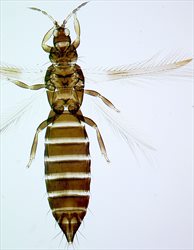
Female
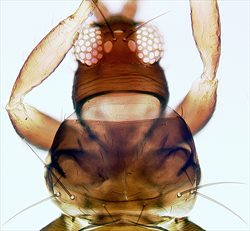
Head & pronotum
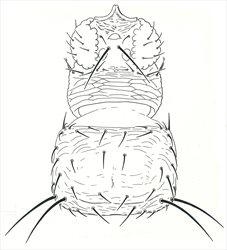
Head & pronotum

Antenna

Antenna
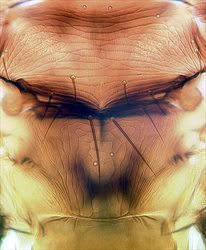
Meso & metanota
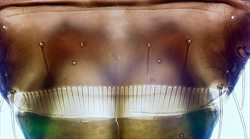
Tergite VIII
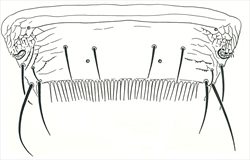
Tergite VIII
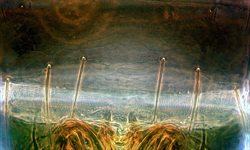
Female sternite VII
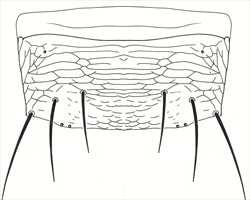
Female sternite VII

Fore wing
Both sexes fully winged. Body brown, tarsi paler, antennal segment III largely yellow; fore wings light brown, base pale. Antennae 8-segmented; segments III–IV constricted distally, each with forked sense cone. Head longer than wide, with convex cheeks; without sculpture between ocelli; two pairs of ocellar setae present, pair III more than 0.5 as long as width of head across eyes, arising within ocellar triangle. Pronotum with few discal setae, 2 pairs of long posteroangular setae; posterior margin with two pairs of small setae laterally and one pair of prominent setae medially arising in front of margin. Mesonotum with paired anterior campaniform sensilla; median pair of setae arise in front of posterior margin. Metanotum weakly reticulate; median setae at anterior margin; campaniform sensilla present. Fore wing first vein with 2–4 setae on distal half; second vein with complete row of about 14 setae. Fore tarsus without a terminal claw. Abdominal tergites with no sculpture medially; tergites VI–VIII with median setae almost half length of tergite; tergite VIII with posteromarginal comb of long regular microtrichia; IX with 2 pairs of campaniform sensilla, X with long median split. Sternites without discal setae, VII with setal pairs S1 and S2 arising in front of margin.
Male smaller than female; sternites III–VII with large transverse pore plate medially.
Currently there are 51 species listed in the genus Taeniothrips, but 21 of these are known only from fossils. Of the remaining species, four are European in origin, one is from western North America, and the rest are from Asia (Mound, Azidah & Ng, 2012). T. picipes is closely related to T. zurstrasseni from Poland, but that species has the median setae on tergite I unusually long, and the metanotal median setae distant from the anterior margin of this sclerite. A distinct species within Europe, the relationship of picipes to two Asian species, orchidi and oreophilus, remains uncertain (Mound, Azidah & Ng, 2012).
In Britain, first found in various herbs that flower in Spring, including Primula and Anemone, and then throughout the summer.
Widespread across Europe, possibly to northern India (Mound, Azidah & Ng, 2012), this species is reported in Britain from Kent and Pembrokeshire to the Shetland Islands, and is also known from both Northern Ireland and from the Republic of Ireland (Mound et al., 1976).
THRIPIDAE - THRIPINAE
Taeniothrips picipes (Zetterstedt)
Thrips picipes Zetterstedt, 1828: 561
Thrips primulae Haliday, 1836: 449
Thrips decora Haliday, 1836: 449
Physopus primulae var. adusta Uzel, 1895: 120
Euthrips alpina Karny, 1908: 279
Taeniothrips primulae f. brevicornis Priesner, 1920: 55
Mound LA, Azidah AA & Ng YF (2012) Key to the non-fossil species of the genus Taeniothrips (Thysanoptera, Thripidae). Zootaxa 3414: 33–42.
Mound LA, Morison GD, Pitkin BR & Palmer JM (1976) Thysanoptera. Handbooks for the Identification of British Insects 1 (11): 1–79.